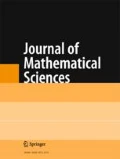Abstract
We consider a continuous-time symmetric, spatially homogeneous branching random walk on a multidimensional lattice with a single branching source. Corresponding transition intensities of the underlying random walk are assumed to have heavy tails. This assumption implies that the variance of jumps is infinite. The growth rate estimate of the Fourier transform for transition intensities and of the asymptotics of the mean number of particles in the source in subcritical case are obtained.
Similar content being viewed by others
References
A. Agbor, S. Molchanov, and B. Vainberg, “Global limit theorems on the convergence of multidimensional random walks to stable processes,” Stoch. Dyn., 15, No. 3, 1550024 (2015).
S. Albeverio, L. V. Bogachev, and E. B. Yarovaya, “Asymptotics of branching symmetric random walk on the lattice with a single source,” C. R. Acad. Sci. Paris. Sér. I, Math., 326, 975–980 (1998).
A. Borovkov and K. Borovkov, Asymptotic Analysis of Random Walks. Heavy-Tailed Distributions, Cambridge Univ. Press, Cambridge (2008).
W. Feller, An Introduction to Probability Theory and Its Applications, Vols. I, II, Wiley, New York (1970, 1971).
V. Kozyakin, “Hardy type asymptotics for cosine series in several variables with decreasing power-like coefficients,” Int. J. Adv. Res. Math., 5, 35–51 (2016).
A. I. Rytova and E. B. Yarovaya, “Multidimensional Watson lemma and its applications,” Math. Notes, 99, No. 3, 406–412 (2016).
V. A. Vatutin and V. A. Topchii, “Limit theorem for critical catalytic branching random walks,” Theory Probab. Appl., 49, No. 3, 498–518 (2005).
E. B. Yarovaya, “Use of spectral methods to study branching processes with diffusion in a noncompact phase space,” Theor. Math. Phys., 88, No. 1, 690–694 (1991).
E. B. Yarovaya, Branching Random Walks in an Inhomogeneous Medium [in Russian], Center for Appl. Stud., Dept. of Mech. and Math., Moscow State University, Moscow (2007).
E. Yarovaya, “Branching random walks with heavy tails,” Commun. Statist. Theory Methods, 42, No. 16, 2301–2310 (2013).
E. Yarovaya, “Criteria for transient behavior of symmetric branching random walks on ℤ and ℤ2,” in: J. R. Bozeman, V. Girardin, and C. H. Skiadas, eds., New Perspectives on Stochastic Modeling and Data Analysis, ISAST (2014), pp. 283–294.
E. B. Yarovaya, “The structure of the positive discrete spectrum of the evolution operator arising in branching random walks,” Dokl. Math., 92, No. 1, 507–510 (2015).
E. B. Yarovaya, “Spectral asymptotics of supercritical branching random process,” Teor. Verojatnost. Primenen., 62, No. 3, 518–541 (2017).
Author information
Authors and Affiliations
Corresponding author
Additional information
Translated from Fundamentalnaya i Prikladnaya Matematika, Vol. 23, No. 1, pp. 175–189, 2020.
Rights and permissions
About this article
Cite this article
Rytova, A.I. Harmonic Analysis of Branching Random Walks with Heavy Tails. J Math Sci 262, 514–524 (2022). https://doi.org/10.1007/s10958-022-05832-w
Published:
Issue Date:
DOI: https://doi.org/10.1007/s10958-022-05832-w


